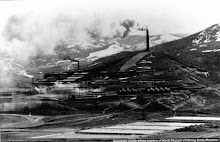ANACONDA - Contaminated sediment hauled from the former Milltown reservoir near Missoula to just west of Opportunity appears headed for cover.
The roughly 2.2 million cubic yards of waste is stubborn to grow grass after treatment, disrupting original plans to use the dirt as a cap over existing mine tailings in the Atlantic Richfield repository.
Instead, Arco and the Environmental Protection Agency may need to cap the toxic material with borrowed soil, a process that could take another two years.
Project leaders detailed these developments at a heated public meeting Tuesday in the Anaconda courthouse, stirring frustration from residents and county officials.
Jim Kuipers, county Superfund technical adviser, told The Montana Standard they had felt all but assured the Milltown sediment would grow vegetation when trains began hauling it over in 2007.
High metallic, nitrate and salt content actually made it more harmful than what was already at the repository, Kuipers said.
"We all drank the Kool-Aid that the sediment would grow," he said. "In the process, the possibility it would not work was underemphasized."
Anaconda no longer has any patience for experimentation, Kuipers said.
"I feel this county is behaving stupendously in light of the fact that these things keep happening," he said.
George Niland, spokesman for the Opportunity Citizens Protection Association, agreed the community is ready for development instead of setbacks.
Niland told The Standard they are fed up, and hear the same answers every time.
"We really thought this would be a great addition to that area," he said. "Turns out, we may be looking at more dust storms."
Arco has until March 31 to recommend soil capping or another plan to the EPA for approval. A final design would then be put together by the end of 2011 for work to begin in 2012.
Estimates come in at $10 million for a six-inch soil cap, and $20 million for an 18-inch cap. Arco is responsible for the cost.
EPA remedial project manager Charlie Coleman told The Standard they accounted for a contingent soil cap from the start, based on analytical data from previous testing.
The EPA was optimistic they could treat the sediment and grow vegetation, Coleman said, despite high levels of metals such as arsenic and lead.
Pyritic materials also created concern about the sediment's acidity in the future, he said.
Still, the EPA had successfully treated similar soil in the past, and its contingency lent a course of action if treatment failed.
"We knew we were working with some uncertainties," Coleman said. "I think what surprised us is how widespread the failure was."
Experts are still struggling to understand why the sediment won't grow vegetation. The sediment, which had been under about 30 feet of water at the reservoir, could have undergone unanticipated chemical reaction when it was brought above surface, Coleman said.
"The inaccessibility of the material did create some (testing) limitations," he said. "We tried to form the best decision we could with the data we had at the time."
Had the plan worked, it would have brought new cover soil to an area where it is sparse.
The sediment was already coming to Anaconda, Coleman said, and their only gamble was to see if they could make use of it in their design.
The EPA is surprised and disappointed it has not worked, he said, and is dedicated to fixing the problem.
"It is our obligation to get this right," he said.
- Reporter George Plaven may be reached via e-mail at george.plaven@lee.net.





1 comment:
http://dl3mashael.blogspot.com/2011/01/beautiful-voice-voice-of-tortured.html
Post a Comment